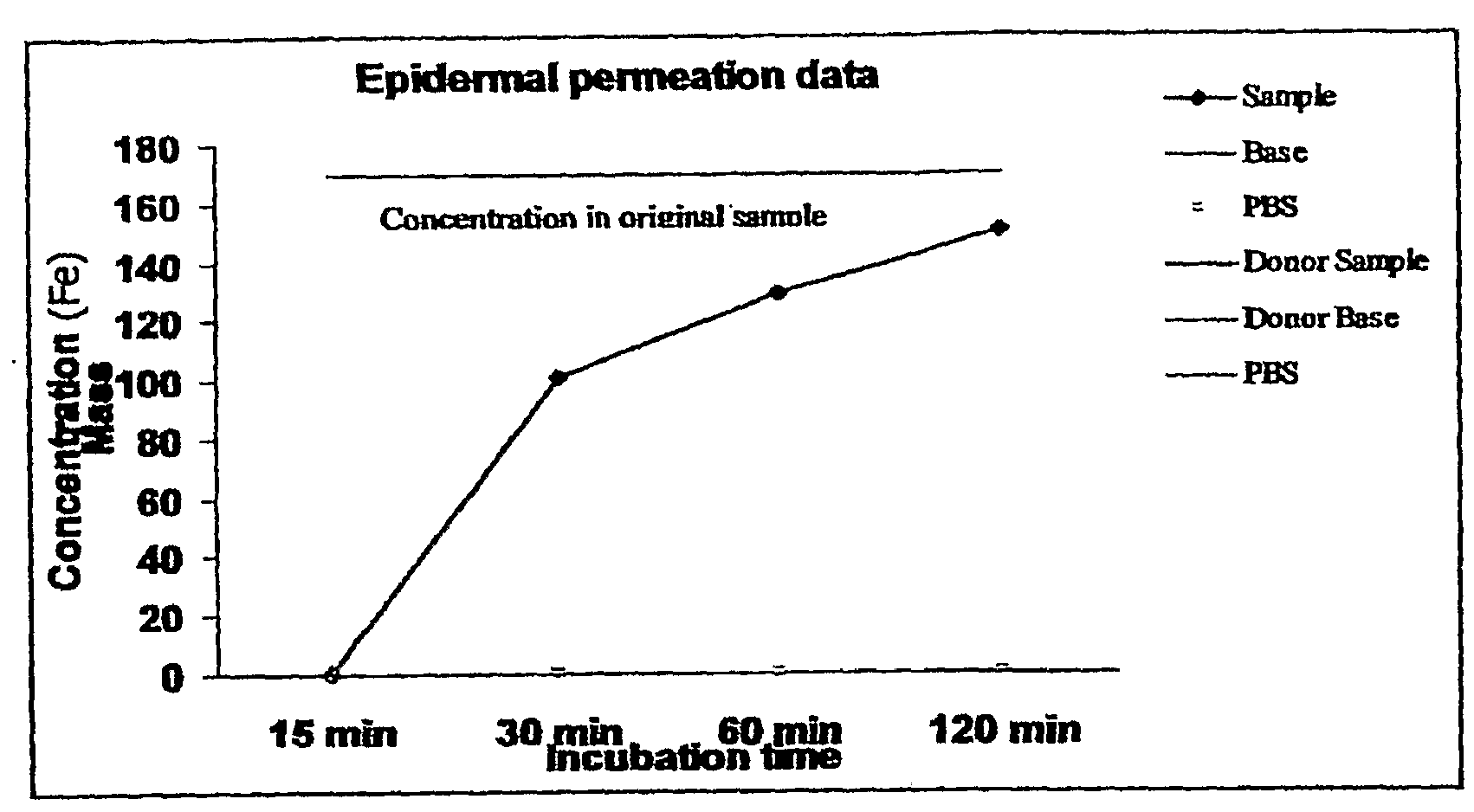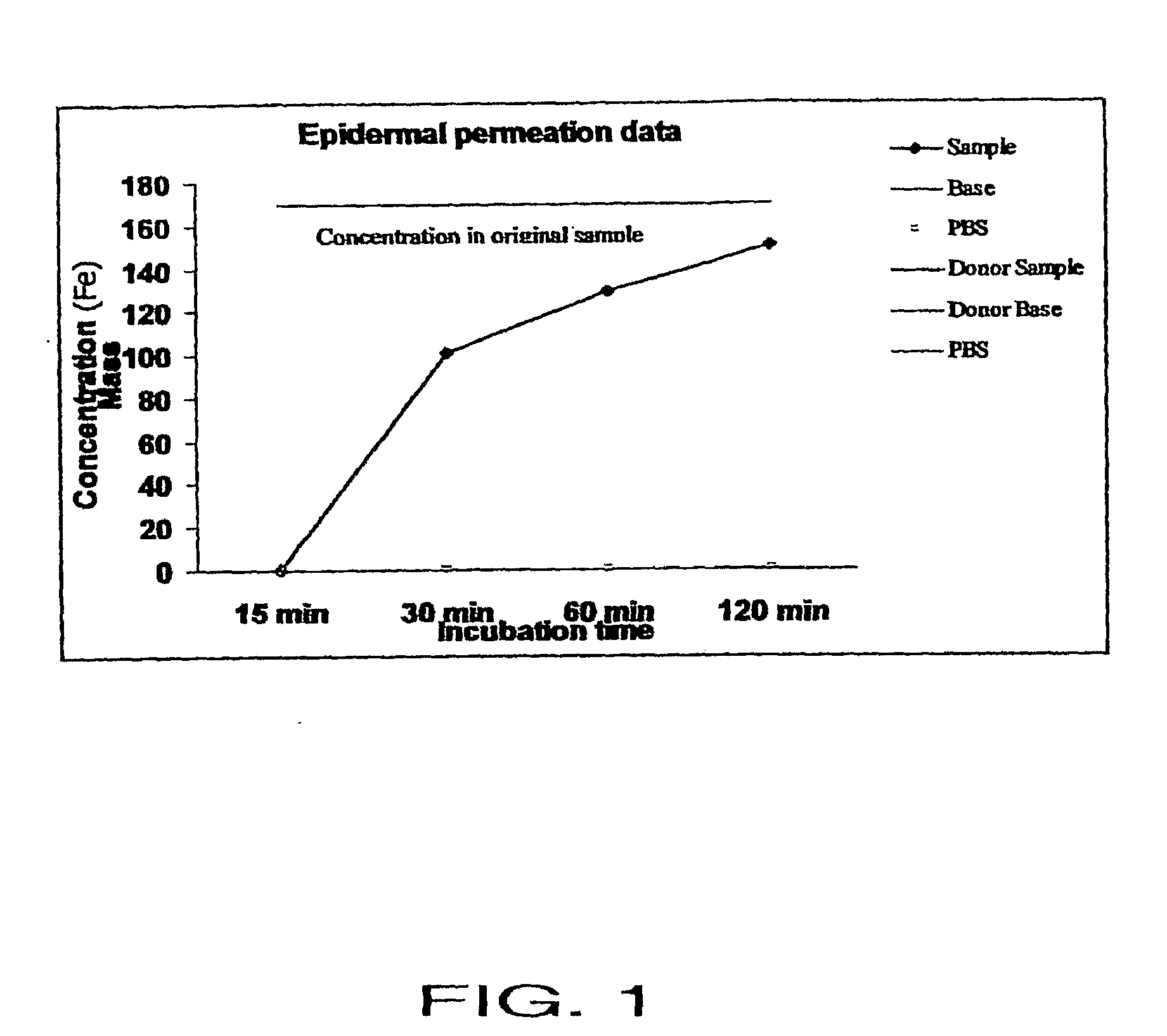Transdermal drug delivery compositions and topical compositions for application on the skin
- Summary
- Abstract
- Description
- Claims
- Application Information
AI Technical Summary
Benefits of technology
Problems solved by technology
Method used
Image
Examples
experimental example 1
Penetration of the Transdermal Delivery Compositions
[0070]A study was performed to confirm that the inventive transdermal delivery compositions rapidly penetrate the human skin. In particular, the study was conducted to determine: 1) whether the transdermal delivery compositions penetrate the human skin; and 2) how long it takes for the transdermal delivery composition to penetrate the skin.
[0071]The “skin” used for the study was EpiDerm™ Skin Model (EPI-200×) (MatTek Corp.), a human skin equivalent. This skin equivalent includes normal, human-derived epidermal keratinocytes and normal, human-derived dermal fibroblasts which have been cultured to form a multilayered, highly differentiated model of the human dermis and epidermis. The tissues are cultured on specially prepared cell culture inserts using a serum free medium to attain levels of differentiation on the cutting edge of in vitro skin technology. The EpiDerm™ Skin Model closely parallels human skin, thus providing a useful i...
experimental example 2
Bioactivity of the Transdermally Delivered Agent
[0079]A second study was performed to determine whether the transdermally delivered compound remains bioactive. In particular, the second study was conducted to determine whether the delivered compound affects the dermal fibroblasts, and whether it induces procollagen synthesis in those cells.
[0080]Pro-collagen synthesis was measured by a real time PCR machine in human dermal fibroblasts (cell line purchased from Cambrex Bio Sciences Walkersville, Inc.) following exposure to the compound. In this study, a specimen cream including a formulation of 2% by weight benzyl alcohol and 0.6% by weight lecithin organogel was compared with a control base.
[0081]A real time PCR method was used to determine collagen message levels in the human dermal fibroblast cell lines exposed to the specimen cream at a concentration of 0.25 mg / ml and the control base at a concentration of 0.25 mg / ml. Cells incubated in media alone served as negative controls.
[00...
experimental example 3
Effect of Proanthocyanidin on Collagen Stability
[0191]A. Cytotoxicity
[0192]NIH 3T3 cells were used in these studies. Cells were cultured in 24-well plates at a density of 5×106 cells / well in 10% FBS / DMEM overnight. The medium was then replaced with complete medium supplemented with proanthocyanidin (MegaNatural, provided by Polyphenolics (Madera, Calif.)), in concentrations of 0, 20, 100, or 200 μg / mL, or glutaraldehyde (GA) in concentrations of 0, 0.1, 0.5, 1.0, or 5.0 μg / mL. Cells were incubated for 72 hours before cell counting and morphological studies.
[0193]B. Fixation Process
[0194]Fresh bovine tendon, pericardium strips, and processed collagen sponges (prepared with bovine tendon atelopeptide-collagen) were fixed with either 0.5% proanthocyanidin PBS solution (pH 7.4) or 0.625% GA / PBS solution for 48 hours at room temperature.
[0195]C. In Vitro Enzymatic Degradation
[0196]Proanthocyanidin-fixed tendon tissue together with fresh controls were digested with 0.2% collagenase (Worth...
PUM
| Property | Measurement | Unit |
|---|---|---|
| Fraction | aaaaa | aaaaa |
| Fraction | aaaaa | aaaaa |
| Fraction | aaaaa | aaaaa |
Abstract
Description
Claims
Application Information
 Login to View More
Login to View More - R&D
- Intellectual Property
- Life Sciences
- Materials
- Tech Scout
- Unparalleled Data Quality
- Higher Quality Content
- 60% Fewer Hallucinations
Browse by: Latest US Patents, China's latest patents, Technical Efficacy Thesaurus, Application Domain, Technology Topic, Popular Technical Reports.
© 2025 PatSnap. All rights reserved.Legal|Privacy policy|Modern Slavery Act Transparency Statement|Sitemap|About US| Contact US: help@patsnap.com



